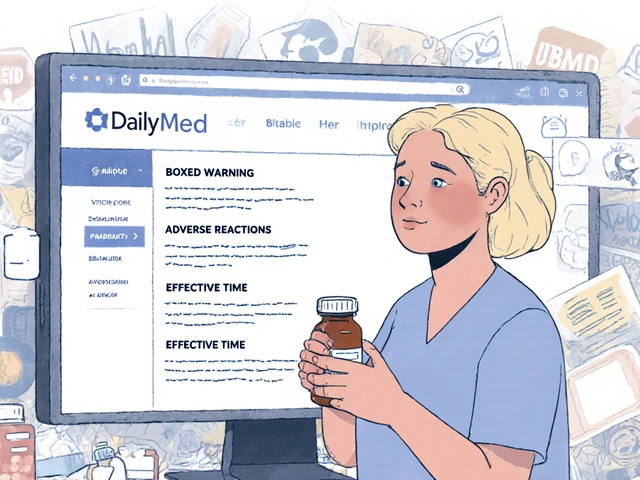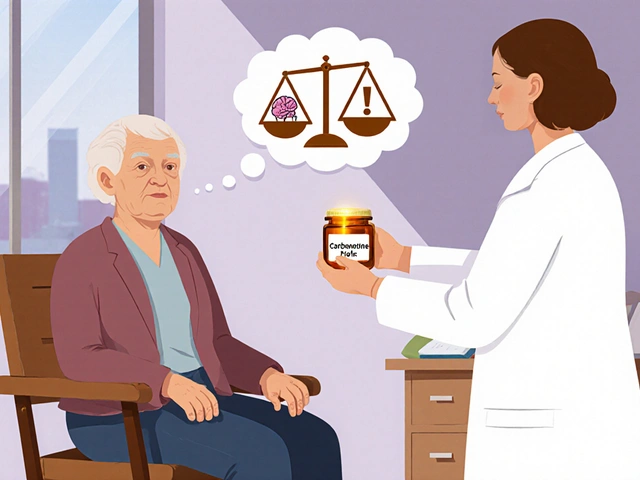Antidepressant Comparison Tool
Recommended Medications
Class: Tricyclic Antidepressant (TCA)
Typical Dose: 25–150 mg daily
Main Uses: Depression, Neuropathic Pain, Migraine Prophylaxis
Onset: 2–4 weeks
Common Side Effects:
- Dry mouth
- Constipation
- Blurred vision
- Weight gain
- Orthostatic hypotension
Class: Selective Serotonin Reuptake Inhibitor (SSRI)
Typical Dose: 50–200 mg daily
Main Uses: Depression, Anxiety, OCD
Onset: 1–2 weeks
Common Side Effects:
- Nausea
- Diarrhea
- Insomnia
- Sexual dysfunction
- Headache
Class: Serotonin-Norepinephrine Reuptake Inhibitor (SNRI)
Typical Dose: 30–120 mg daily
Main Uses: Depression, Generalized Anxiety, Chronic Pain
Onset: 2–3 weeks
Common Side Effects:
- Nausea
- Dizziness
- Increase in blood pressure
- Liver enzyme elevation
Class: Atypical Antidepressant (NDRI)
Typical Dose: 150–300 mg daily
Main Uses: Depression, Smoking Cessation, ADHD
Onset: 1–3 weeks
Common Side Effects:
- Insomnia
- Dry mouth
- Anxiety
- Rare seizures at high doses
When a doctor prescribes a mood‑lifting or pain‑relieving pill, most patients wonder how that drug stacks up against the many other options on the market. Amitriptyline is a tricyclic antidepressant (TCA) originally approved for major depressive disorder but now widely used for chronic neuropathic pain, migraines, and sleep disturbances. Understanding its strengths, drawbacks, and where newer agents fit in can save you from trial‑and‑error cycles and unwanted side effects.
What Makes Amitriptyline Unique?
Amitriptyline works by boosting the levels of serotonin and norepinephrine in the brain, while also blocking histamine and acetylcholine receptors. This broad receptor profile explains why it can help both mood and pain, but it also accounts for many of its classic side effects such as dry mouth, drowsiness, and weight gain. Most clinicians start patients at 25mg at night and titrate up to 150mg daily, tailoring the dose to the specific condition being treated.
Key Alternatives to Consider
Over the past two decades, newer drug classes have entered the scene, offering comparable efficacy with a cleaner side‑effect profile. Below are the most common alternatives:
- Sertraline - an SSRI that selectively boosts serotonin, popular for depression, anxiety, and OCD.
- Duloxetine - an SNRI that targets both serotonin and norepinephrine, approved for depression, generalized anxiety disorder, and chronic musculoskeletal pain.
- Bupropion - an atypical antidepressant that inhibits norepinephrine‑dopamine reuptake, useful for depression, smoking cessation, and ADHD.
- Nortriptyline - a TCA closely related to amitriptyline but generally better tolerated for chronic pain.
Comparing Efficacy and Tolerability
Clinical trials consistently show that all four agents reduce depressive symptoms by roughly 30‑40% over placebo. However, the speed of improvement and the side‑effect burden differ. Amitriptyline’s sedating effect can be an advantage for patients who also suffer from insomnia, while SSRIs like sertraline are favored when sexual dysfunction is a primary concern because they tend to cause fewer anticholinergic symptoms.
Side‑Effect Profiles at a Glance
Below is a quick cheat‑sheet of the most frequently reported adverse events for each drug.
- Amitriptyline: dry mouth, constipation, blurred vision, weight gain, orthostatic hypotension.
- Sertraline: nausea, diarrhea, insomnia, sexual dysfunction, headache.
- Duloxetine: nausea, dizziness, increased blood pressure, liver enzyme elevation.
- Bupropion: insomnia, dry mouth, anxiety, rare seizures at high doses.
Direct Comparison Table
| Drug | Class | Typical Daily Dose | Main Indications | Common Side Effects | Onset of Action |
|---|---|---|---|---|---|
| Amitriptyline | Tricyclic Antidepressant | 25‑150mg | Depression, Neuropathic Pain, Migraine Prophylaxis | Dry mouth, Drowsiness, Weight gain | 2‑4 weeks |
| Sertraline | Selective Serotonin Reuptake Inhibitor | 50‑200mg | Depression, Anxiety, OCD | Nausea, Sexual dysfunction, Insomnia | 1‑2 weeks |
| Duloxetine | Serotonin‑Norepinephrine Reuptake Inhibitor | 30‑120mg | Depression, Generalized Anxiety, Chronic Pain | Nausea, Blood pressure rise, Liver enzyme changes | 2‑3 weeks |
| Bupropion | Atypical Antidepressant (NDRI) | 150‑300mg | Depression, Smoking cessation, ADHD | Insomnia, Dry mouth, Anxiety | 1‑3 weeks |
How to Choose the Right Option
Think of medication selection as a decision tree. Start with the primary goal-mood improvement, pain relief, or sleep support. Then ask:
- Do I have existing heart problems or take other meds that could interact with anticholinergic drugs? If yes, avoid TCAs like amitriptyline.
- Is daytime sedation a deal‑breaker? If so, pick a non‑sedating SSRI or SNRI.
- Do I need help quitting smoking? Bupropion may give you a dual benefit.
- Am I pregnant or breastfeeding? Some SSRIs have more safety data than TCAs.
When in doubt, discuss these checkpoints with your prescriber. The right drug often balances efficacy with the side‑effects you’re willing to tolerate.

Safety, Interactions, and Monitoring
All antidepressants have the potential to affect heart rhythm, especially in patients over 65 or those with congenital long QT syndrome. Amitriptyline, being a TCA, carries the highest risk of cardiac conduction delays, so an ECG before starting high doses is prudent. SSRIs and SNRIs can interact with CYP450 enzymes, leading to altered blood levels of statins, anticoagulants, or certain anti‑epileptics. Bupropion lowers the seizure threshold, so avoid it if you have a history of seizures.
Regular follow‑ups-usually after 2-4 weeks-let clinicians gauge response and adjust the dose. Blood tests are rarely needed for most antidepressants, but duloxetine and bupropion may require liver function checks in patients with hepatic disease.
Practical Tips for Managing Side Effects
- Dry mouth (Amitriptyline): Sip water, chew sugar‑free gum, or use saliva substitutes.
- Insomnia (SSRI/SNRI): Take the dose in the morning; consider a short‑acting sleep aid if needed.
- Weight gain (TCAs): Pair the medication with a balanced diet and regular exercise; monitor weight monthly.
- Sexual dysfunction (SSRIs): Dose reduction, “drug holidays,” or switching to bupropion can help.
When to Switch or Augment
If you’ve tried a therapeutic dose for at least six weeks with minimal improvement, consider a switch to a different class. Augmentation-adding a second agent like lithium or an atypical antipsychotic-can boost response, especially in treatment‑resistant depression. However, each addition raises the risk of drug-drug interactions, so a thorough medication review is essential.
Frequently Asked Questions
Is amitriptyline still prescribed for depression in 2025?
Yes, but mostly for patients who also need pain relief or have not responded to newer agents. Many clinicians reserve it for a specific niche because of its side‑effect profile.
Can I take amitriptyline with a selective serotonin reuptake inhibitor?
Combining two serotonergic drugs raises the risk of serotonin syndrome-a potentially serious condition. It should only be done under close medical supervision, and often a wash‑out period is required.
Why does amitriptyline cause drowsiness while sertraline does not?
Amitriptyline blocks histamine H1 receptors, which promotes sedation. Sertraline has negligible antihistamine activity, so it tends to be more activating.
Is it safe to stop amitriptyline abruptly?
Abrupt cessation can trigger withdrawal symptoms like nausea, dizziness, and flu‑like sensations. A gradual taper over several weeks is recommended.
Which alternative is best for chronic neuropathic pain?
Duloxetine and nortriptyline are both FDA‑approved for neuropathic pain. Duloxetine offers a more favorable side‑effect profile for many patients, while nortriptyline may work better for those who also need sleep support.




Jolanda Julyan
October 9, 2025 AT 20:35Alright, let’s get straight to the point about amitriptyline and its rivals. Amitriptyline is an old‑school drug that still hangs around because it hits both mood and pain, but it comes with a laundry list of side effects that many people can’t tolerate. You start low, maybe 25 mg at night, and you may have to climb up to 150 mg before you see any benefit, and that can take weeks. The dry mouth, the weight gain, the drowsiness – they’re not just minor annoyances, they can ruin daily life. If you’re already dealing with depression, adding constipation and blurred vision feels like a punishment. Compared to sertraline, which mostly gives you nausea or a bit of insomnia, amitriptyline drags you down with sedation and orthostatic drops. Duloxetine might raise your blood pressure, but at least it doesn’t make you feel like a zombie in the morning. Bupropion avoids the anticholinergic crowd, yet it can stir up anxiety and insomnia, which is the opposite of what you need for sleep. The reality is that amitriptyline works for some, especially when you need that extra night‑time sedation for insomnia, but it’s a gamble if you’re sensitive to weight gain. Doctors should not just throw it at anyone with depression; a careful review of heart health and other meds is mandatory. The cardiac risk, especially in older patients, is real – an ECG before high doses is a must. If you can tolerate the side effects, the pain relief for neuropathy can be worth it, but many patients end up switching to duloxetine or nortriptyline for a cleaner profile. Bottom line: amitriptyline is a blunt instrument – effective for some, but often too harsh for the majority. So think twice, weigh the pros and cons, and have a solid plan with your doctor before you start. Remember, consistency and monitoring are key to making any antidepressant work safely.
Kevin Huston
October 11, 2025 AT 00:21Look, the American drug market loves pushing cheap TCAs like amitriptyline while pretending the fancy SSRIs are the only smart choice, but that's just a sales gimmick. Our own insurers keep the cost low by preferring older meds, and that’s a win for the bottom line, not the patient.
Nolan Jones
October 12, 2025 AT 04:08Yeah, the cost factor is real, and many people end up on amitriptyline simply because it’s cheap. If you’re worried about the side effects, start at a low dose at night and watch how you feel in the morning. Hydrating and chewing sugar‑free gum can help with that nasty dry mouth. Keep an eye on your weight and blood pressure, and let your doc know if you feel dizzy when you stand up. It’s not perfect, but for a lot of chronic pain patients it actually does the trick.
Emily Rossiter
October 13, 2025 AT 07:55That’s solid advice-starting low and monitoring is the safest route. Also, pairing the medication with gentle exercise can offset some weight gain and improve mood overall. If drowsiness is a problem, try taking it a few hours before bedtime so you wake up refreshed. Discuss any cardiac concerns with your physician; a baseline ECG is a smart move. Remember, you’re not alone in this, and tweaking the regime can make a big difference.
Sandy Martin
October 14, 2025 AT 11:41I totally get how overwhelming all the info can feel, especially when you’re juggling pain and mood swings. It’s okay to take things step by step and check in with your doctor regularly. Having a journal of side effects helps the doc adjust the dose faster. If you ever feel like the med is too much, don’t hesitate to reach out for a quick consult. You deserve a treatment plan that works for you.
Amanda Hamlet
October 15, 2025 AT 15:28Honestly, you guys need to stop pretending you’re the all‑knowing experts on my prescription, because I’m an American and we’ve been using these meds forever. I’ve read every study you’re quoting, and frankly, most of them are just hype from overseas labs. My doctor told me to stick with amitriptyline for its sedating power, so I’m not gonna jump ship just because some forum says otherwise. If you think you’re better than me, keep it to yourself.
Jada Singleton
October 16, 2025 AT 19:15Skipping the nuance, you’re merely echoing outdated hype without personal evidence.
Mithun Paul
October 17, 2025 AT 23:01While your succinct dismissal may appear authoritative, a rigorous analysis would necessitate citation of recent comparative trials between amitriptyline and contemporary serotonergic agents, rather than reliance on anecdotal assertions.
Steve Smilie
October 19, 2025 AT 02:48Indeed, the very tapestry of pharmacological discourse demands an eloquent weaving of data, lest we descend into the prosaic mire of unsubstantiated conjecture that plagues pedestrian dialogues.
Josie McManus
October 20, 2025 AT 06:35Okay, I hear you-so many fancy words, but at the end of the day we just want a med that actually helps without turning us into a lab rat.
Heather Kennedy
October 21, 2025 AT 10:21Utilizing precise pharmaco‑kinetic terminology, one could argue that amitriptyline’s high lipophilicity and antihistaminic profile confer both therapeutic advantage and adverse effect potential, necessitating a risk‑benefit calculus tailored to individual patient phenotypes.
Renee van Baar
October 22, 2025 AT 14:08When navigating the landscape of antidepressant options, it helps to map your primary therapeutic goal-whether it’s mood elevation, analgesia, or sleep promotion-and then align that with each drug’s pharmacodynamic footprint. Amitriptyline shines in scenarios where sedation and neuropathic pain relief are prized, yet its anticholinergic burden can be a drawback for many. SSRIs such as sertraline offer a cleaner side‑effect slate but lack the analgesic punch, whereas SNRIs like duloxetine strike a middle ground with both mood and pain efficacy. Bupropion presents a non‑sedating alternative that sidesteps many of the classic TCA side effects, though it may exacerbate anxiety for some. Ultimately, a shared decision‑making conversation with your clinician, informed by your symptom profile and tolerance thresholds, will guide the optimal choice.